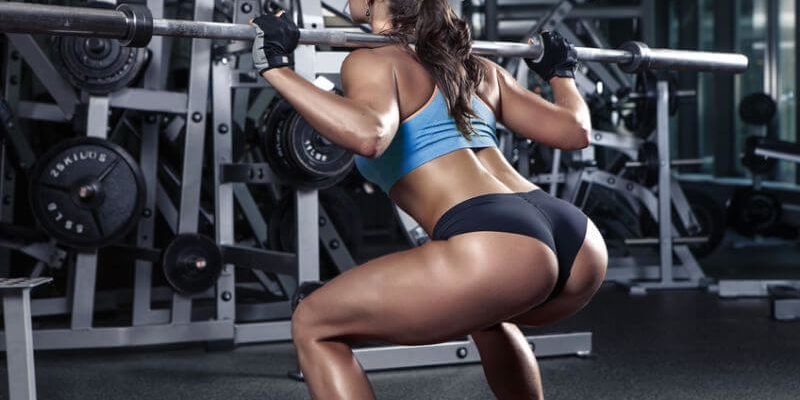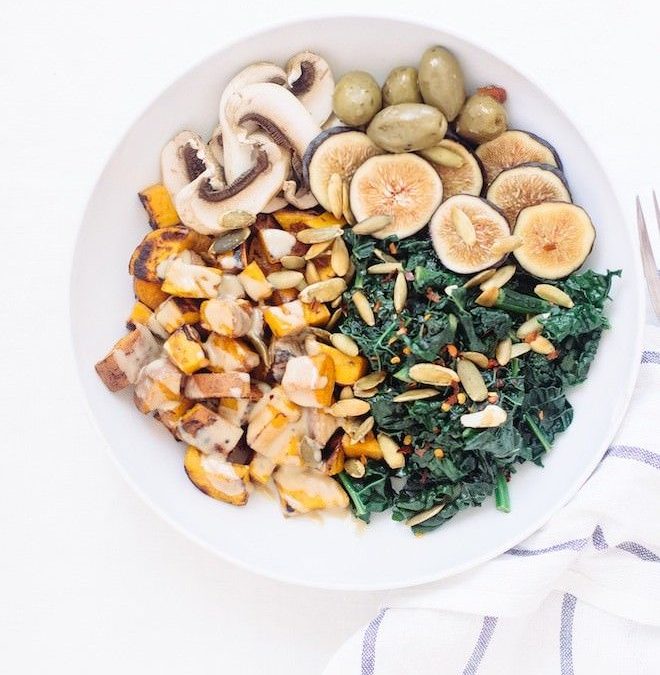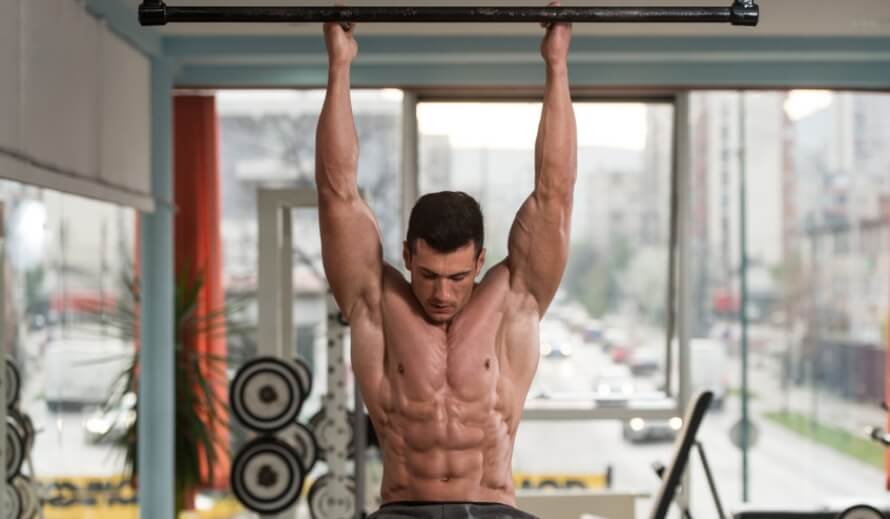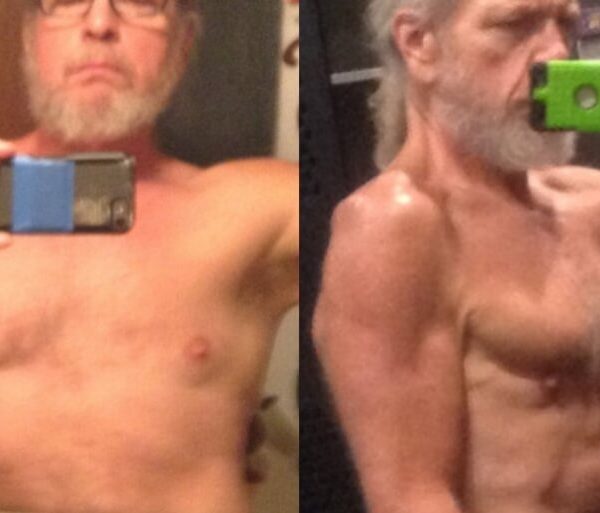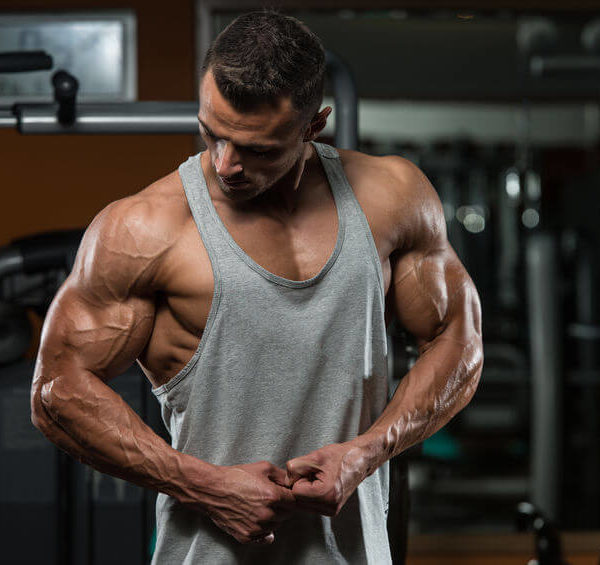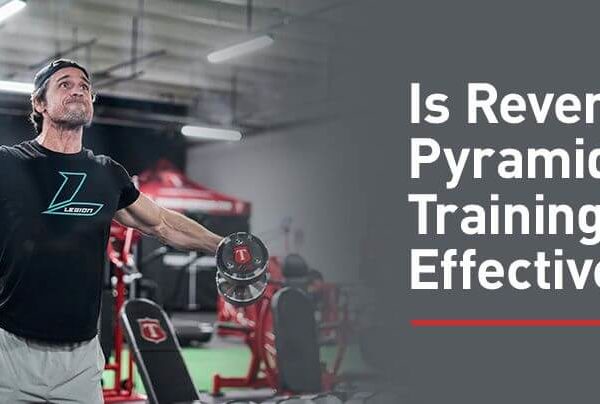How to Get a Bigger Butt Fast: Exercises & Tips
Few things turn heads quite like a killer butt.
We just can’t help but ogle a pair of round, perky glutes.
What’s more, the glutes are one of the largest muscle groups in your body, and play a key role in many different exercises from back squatting to running to basketball.
That’s why so many of us—guys and gals alike—want to know how to get a bigger butt.
And if you’re one of them, you’ve come to the right place because by the end of this article, you’re going to know exactly how to get a bigger butt fast, including . . .
- All of the best bigger butt exercises
- Some bigger butt workouts for growing your glutes
- Tips on how to make your butt bigger fast
If you’ve been slaving away at your workouts and don’t have the booty you feel you deserve, that’s going to change when you start doing the butt exercises and workouts in this article.
How to Make Your Butt Bigger
Building a bigger butt mostly comes down to three things:
- Doing the right butt exercises.
- Getting progressively stronger over time.
- Eating enough to support glute growth.
Let’s discuss each now:
1. Do the right butt exercises.
Most guides on how to make your butt bigger recommend spending too much time on isolation exercises and machines, and far too little time on compound exercises.
This is wrongheaded.
The “secret” to building a bigger butt is to get as strong as possible on compound exercises that train your glutes, not puttering around with machines.
This means you should spend the majority of your time in the gym doing exercises like squats, deadlifts, hip thrusts, and lunges, and leaving exercises like cable pull throughs, back extensions, and donkey kicks until the end of your workout.
A good rule of thumb is that 80% of your time and energy should go into compound exercises for your glutes, and the remaining 20% you can give to isolation exercises and machines.
2. Get progressively stronger over time.
If you stop getting stronger, your butt will eventually stop getting bigger (this applies to every major muscle group in the body, by the way—not just your glutes).
That’s why you should also strive to add weight or reps to every exercise in every workout. This is known as progressive overload, and it’s one of the best ways to maximize the muscle-building effects of weightlifting.
And what’s the best way to get stronger?
Ditch the high-rep “pump” training and lift heavy.
And by “heavy,” I mean doing the majority of your butt exercises with weights in the range of 75-to-85% of your one-rep max (1RM), or in the range of 8-to-10 (~75%) to 4-to-6 (~85%) reps.
3. Eat enough to support glute growth.
In order to maximize glute growth you need to maintain a mild calorie surplus.
That is, you need to eat about 110% of your total daily energy expenditure (TDEE) every day.
The reason for this is a calorie surplus optimizes your body’s “muscle-building machinery,” greatly enhancing your body’s ability to recover from and positively adapt to your training.
The one exception to this rule is if you’re brand new to proper weightlifting, in which case you can eat at maintenance and still grow your glutes (a phenomenon known as “newbie gains”). After about your first year of proper training, though, you’ll need to maintain a calorie surplus to keep gaining muscle.
That’s not all, though—you need to eat enough protein to allow your muscles to recover, repair, and grow effectively, too.
If you want to learn exactly how many calories you should eat to build a bigger butt, check out this article:
How Many Calories Should I Eat?
Exercises for Building a Bigger Butt Fast
You now know that when it comes to building a bigger butt, most people focus on the wrong butt exercises.
Not only that, but they spend too much time doing high-rep training instead of getting progressively stronger by lifting heavy.
That’s why the exercises in this article are compound exercises that allow you to lift heavy and safely add weight over time—exactly what you need to build a bigger butt fast.
Barbell Squat
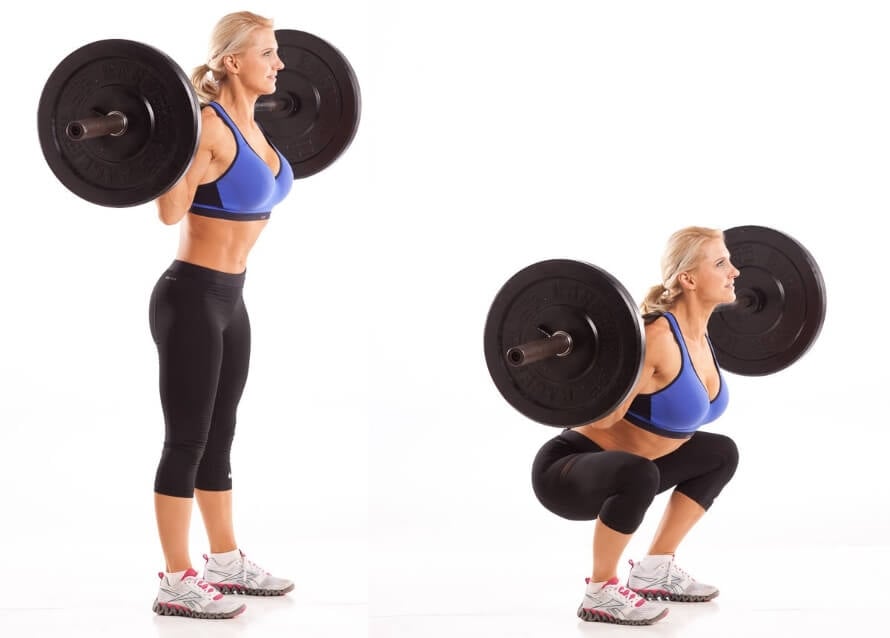
How to:
- Position a barbell in a squat rack at about the height of your breast bone.
- Step under the bar, pinch your shoulder blades together, and rest the bar directly above the bony ridges on the bottom of your shoulder blades.
- Lift the bar out of the rack, take one or two steps backward, and place your feet a little wider than shoulder-width apart with your toes pointing slightly outward.
- Sit down and remember to keep your back straight and push your knees out in the same direction as your toes throughout each rep.
- Stand up and return to the starting position.
Why: The barbell squat is the single most effective exercise for building total body strength and muscularity, and trains the glutes even more than so-called “glute” exercises like the hip thrust. What’s more, research shows that squatting deep—to parallel or deeper—makes the squat an even better booty builder.
Barbell Deadlift
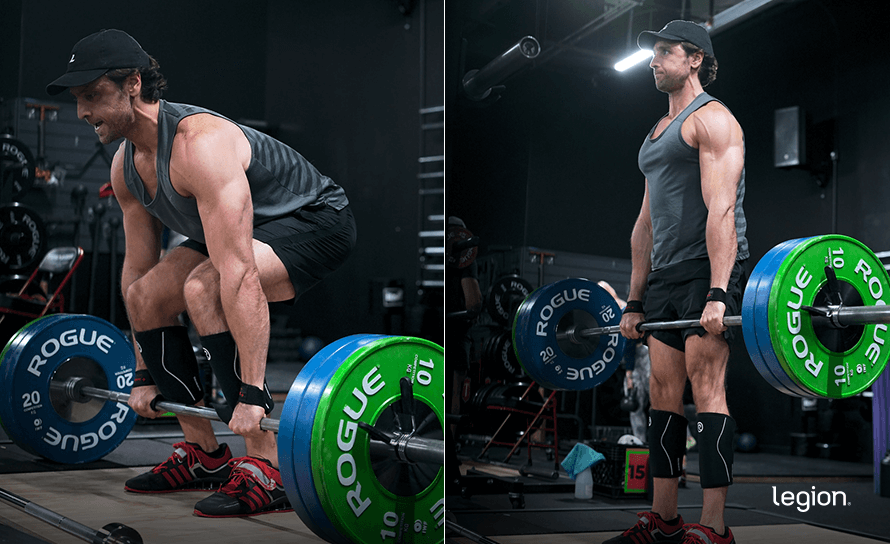
How to:
- Position your feet so they’re slightly narrower than shoulder-width apart with your toes pointed slightly out. Move a loaded barbell over your midfoot so it’s about an inch from your shins.
- Take a deep breath into your belly, then place your hands on the bar just outside your shins.
- Flatten your back and drive your body upward and slightly back by pushing through your heels until you’re standing up straight.
- Reverse the movement and return to the starting position.
Why: The deadlift is hands down the best exercise for training your entire posterior chain (the muscles on the back side of your body, including your glutes). It also allows you to use some of the heaviest weights in any of your workouts, which means it’s ideal for gaining strength and muscle.
Tip: If you can’t do conventional deadlifts for any reason, try sumo deadlifts or trap-bar deadlifts instead. They both train your glutes about a well as the conventional deadlift, but some people find them more comfortable.
Hip Thrust
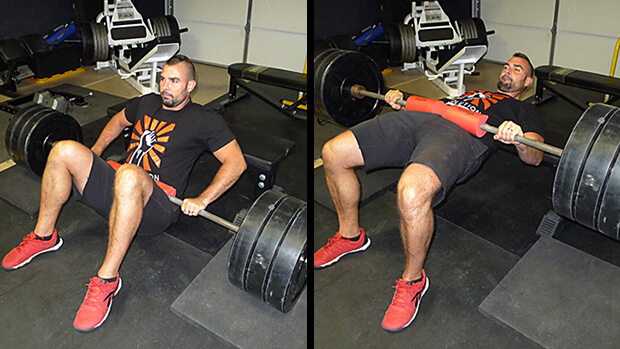
How to:
- Sit on the ground with your back resting against a bench. The bench should be perpendicular to your body and your shoulders should be resting on the middle of the bench.
- Roll a barbell over your thighs so that it sits in your hip crease (use a bar pad to protect your hip bones from bruising and make the exercise more comfortable).
- Plant your feet on the ground about shoulder-width apart with your toes pointing slightly outward and bend your knees to 90 degrees.
- Push the bar upward with your hips by pressing through your heels until your upper body and thighs are parallel to the ground and your shins are vertical.
- Reverse the movement and return to the starting position.
Why: Because of the way the barbell is positioned during hip thrusts, your glutes are forced to work hard throughout the entire range of motion, which is a benefit that’s unique to the hip thrust.
Barbell Lunge
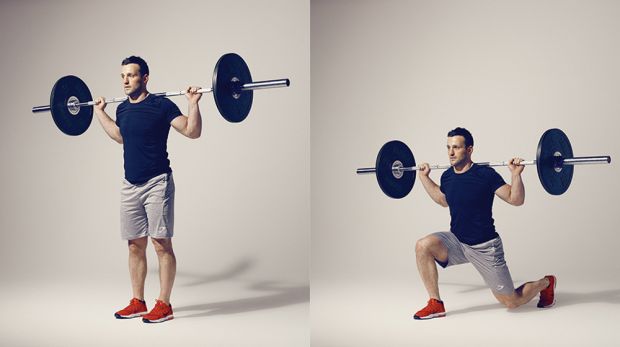
How to:
- Position a loaded barbell across your back so that the bar lies directly above the bony ridges on the bottom of your shoulder blades, and stand up straight with both feet about shoulder-width apart.
- Take a long step forward with your right foot—about two to three feet. With most of your weight on your right foot, kneel down until your left knee touches the floor.
- Push off the floor with your right foot and lean slightly backward, allowing your legs to straighten.
- Once you’re standing, bring your left foot forward so that it’s next to your right foot, then repeat on your left side.
Why: Research shows that lunges are one of the best exercises you can do to train your entire lower body, including your glutes. What’s more, stabilizer muscles across your entire body are trained because your balance and coordination is challenged as you walk.
Dumbbell Lunge
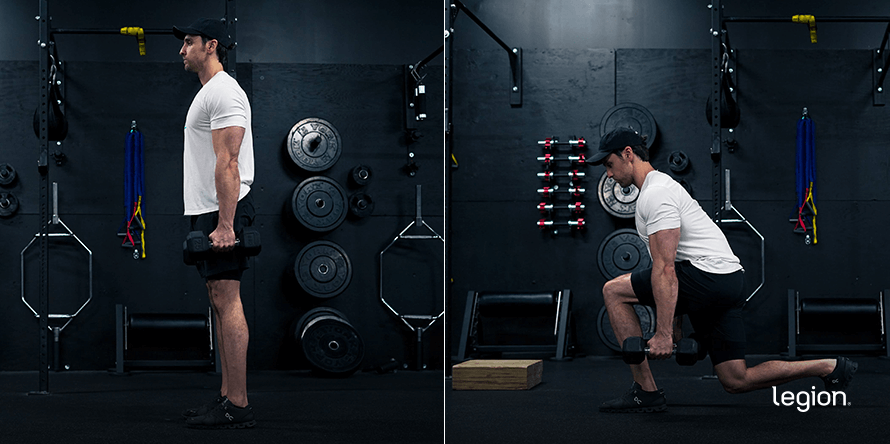
How to:
- Holding a dumbbell in each hand, stand up straight with both feet about shoulder-width apart.
- Take a long step forward with your right foot—about two to three feet. With most of your weight on your right foot, kneel down until your left knee touches the floor.
- Push off the floor with your right foot and lean slightly backward, allowing your legs to straighten.
- Once you’re standing, bring your left foot forward so that it’s next to your right foot, then repeat on your left side.
Why: Research shows that lunges are one of the best exercises you can do to train your entire lower body, including your glutes. Although very similar to the barbell lunge, one of the unique challenges of the dumbbell lunge is that you have to prevent the dumbbells from swinging as you walk. This trains your lower body and stabilizer muscles in a slightly different way than the barbell variation.
Bulgarian Split Squat
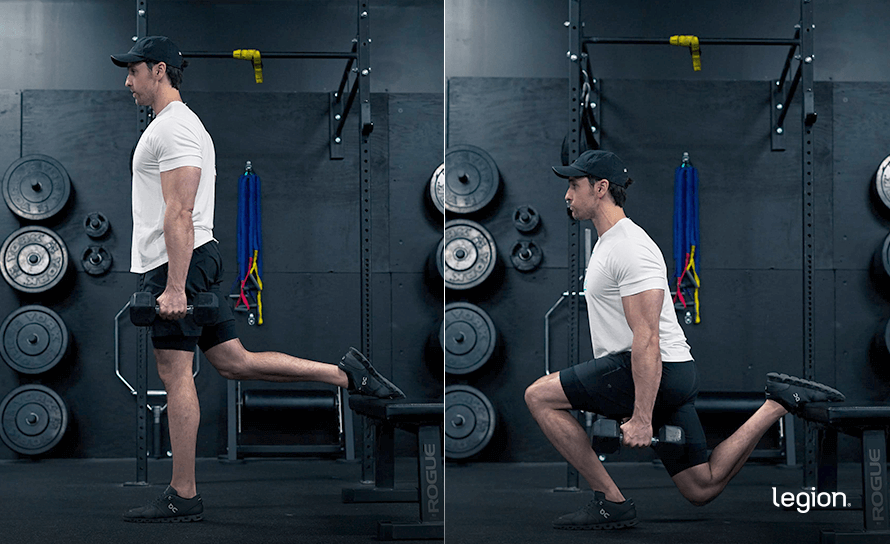
How to:
- While holding a dumbbell in each hand, stand about two-to-three feet in front of a bench.
- With your right foot (and heel in particular) firmly planted, place the top of your left foot on the bench behind you.
- Look at a spot on the floor six-to-ten feet in front of you and lower your butt toward the floor by bending at your right knee.
- Keep lowering yourself until your right thigh is roughly parallel with the floor.
- Stand up and return to the starting position.
Why: Research shows that the dumbbell Bulagrian split squat is a great exercise for training the glutes. Because the Bulgarian split squat trains just one leg at a time, it’s particularly useful for identifying and evening out any muscle or strength imbalances you might have, too.
Romanian Deadlift
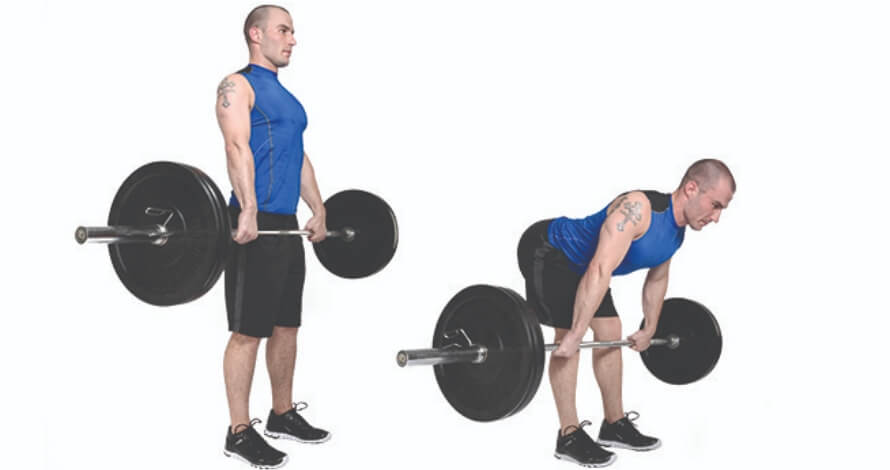
How to:
- Stand up straight holding a loaded barbell with a shoulder-width, overhand grip (palms facing toward your body).
- Flatten your back and lower the weights toward the floor in a straight line while keeping your legs mostly straight, allowing your butt to move backward as you descend.
- Once you feel a stretch in your hamstrings, bend your knees slightly more, and continue lowering the weights until your lower back begins to round—just below the knees for most people, and about mid-shin for those who are particularly flexible.
- Reverse the movement and return to the starting position.
Why: The Romanian deadlift (RDL) trains the posterior chain in a very similar way to the conventional deadlift. However, because of the difference in form, you put a larger emphasis on your hamstrings and glutes rather than your back. It’s also considerably less fatiguing than the conventional deadlift, which means you can do it more often without wearing yourself to a frazzle.
5 Bigger Butt Workouts for Building Your Glutes
So far we’ve covered how you should train and eat to build a bigger butt and the best exercises for growing your glutes. Now it’s time to talk about bigger butt workouts.
Bigger Butt Workout #1: Barbells
- Barbell Back Squat: warm up and 3 sets of 4 to 6 reps
- Romanian Deadlift: 3 sets of 8 to 10 reps
- Barbell Lunges: 3 sets of 8 to 10 reps
- Barbell Hip Thrust: 3 sets of 8 to 10 reps
If you have access to barbells, this is one of the best glute-building workouts you can do. Barbell exercises are ideal for safely implementing progressive overload (lifting heavy weights and getting stronger over time).
Bigger Butt Workout #2: Dumbbells
- Bulgarian Split Squat: warm up and 3 sets of 4 to 6 reps
- Dumbbell Romanian Deadlift: 3 sets of 8 to 10 reps
- Dumbbell Lunge: 3 sets of 8 to 10 reps
If you don’t have access to a barbell, adjustable dumbbells are a great alternative. One of the benefits of many dumbbell exercises is that they train each side of your body independently. This helps you to identify and correct any size or strength imbalances you might have so that your lower-body development is proportionate.
Bigger Butt Workout #3: Barbells & Dumbbells
- Barbell Back Squat: warm up and 3 sets of 4 to 6 reps
- Barbell Hip Thrust: 3 sets of 8 to 10 reps
- Dumbbell Romanian Deadlift: 3 sets of 8 to 10 reps
- Bulgarian Split Squat: 3 sets of 8 to 10 reps
If you want to mix heavy barbell lifting with some supplementary dumbbell work to make sure your lower-body development is balanced, this is the perfect workout for you.
Bigger Butt Workout #4: Body Weight
- Bodyweight Bulgarian Split Squat: warm up and 3 sets of 10 to 20 reps
- Bodyweight Single-Leg Deadlift: 3 sets of 10 to 20 reps
- Bodyweight Glute Bridge: 3 sets of 10 to 20 reps
This bodyweight butt workout is simple, effective, and can be done pretty much anywhere, whether you’ve got access to a gym or not.
Bigger Butt Workout #5: HIIT
Do hill sprints or cycle sprints at high resistance for 1 minute at about 90% of your max effort followed by 1 minute of active recovery. Repeat 10 times for a total of 20 minutes of exercise.
While this type of training isn’t nearly as effective as weight training for building a big butt, it’s the best way to go if you’re dead set on including some cardio in your plan and still want to give your glutes some attention.
4 Tips for Building Bigger Glutes Fast
1. Be patient.
This may sound counterintuitive (isn’t this article about how to get a bigger butt fast?!), but the reality is there’s a limit to how quickly you can build muscle in your glutes (or any other muscle).
Expect to put in 8-to-12 weeks of consistent effort before you see any major changes in how your glutes look or your clothes fit.
Building a great butt is a long-term project, and even after you build the booty you want, you’ll need to continue to train properly if you want to maintain it.
Check out this article if you want to learn more about the natural limits of muscle gain:
Here’s How Much Muscle You Can Really Gain Naturally (with a Calculator)
2. Try to lift more weight in every workout.
One of the simplest and most effective ways to get stronger is a method called double progression.
If you want a full breakdown of exactly what double progression is and how to implement it in your training, check out this podcast, but here’s the long story short:
Work with a weight until you hit the top of your rep range for one set, then move up in weight.
For instance, if you squat 95 pounds for 6 reps on your first 4-to-6 rep set, you then add 5 pounds to each side of the bar for your next set.
If, on the next set, you can get at least 4 reps with 105 pounds, that’s the new weight you work with until you can pull it for 6 reps, move up, and so forth.
If you get 3 or fewer reps, though, reduce the weight added by 5 pounds (100 pounds) and see how the next set goes. If you still get 3 reps or fewer, reduce the weight to the original 6-rep load (95 pounds) and work with that until you can do two 6-rep sets with it, and then increase the weight on the bar.
3. Don’t train too much or too hard.
Don’t make the mistake of “blasting” your glutes with too many sets per workout and taking every set to muscle failure (the point where you can no longer move the weight despite pushing against it). More is not always better.
Not only is this unnecessary, it may even slow down your glute gains in the long run. Instead, you want to end most of your sets about 1-to-2 reps shy of muscle failure.
Personally, I never train to absolute failure for more than 2-to-3 sets per workout, and never on the squat, deadlift, bench press, or military press as this can be dangerous.
4. Take supplements proven to help you build muscle.
I saved this for last because it’s the least important.
Unfortunately, no amount of pills and powders are going to automagically make your butt bigger. In fact, most muscle-building supplements are completely worthless.
But here’s the good news:
If you know how to eat and train to build muscle—following the steps we just covered—certain supplements can speed up the process.
Here are the best supplements for building muscle (including glute muscle):
- 0.8-to-1.2 grams of protein per pound of body weight per day. This provides your body with the “building blocks” it needs to build and repair muscle tissue and help you recover from your workouts. If you want a clean, convenient, and delicious source of protein, try Whey+.
- 3-to-5 grams of creatine per day. This will boost muscle and strength gain, improve anaerobic endurance, and reduce muscle damage and soreness from your butt workouts. If you want a 100% natural source of creatine that also includes two other ingredients that will help boost muscle growth and improve recovery, try Recharge.
- One serving of Pulse per day. Pulse is a 100% natural pre-workout drink that enhances energy, mood, and focus; increases strength and endurance; and reduces fatigue. You can also get Pulse with caffeine or without.
+ Scientific References
- Stokes, T., Hector, A. J., Morton, R. W., McGlory, C., & Phillips, S. M. (2018). Recent perspectives regarding the role of dietary protein for the promotion of muscle hypertrophy with resistance exercise training. In Nutrients (Vol. 10, Issue 2). MDPI AG. https://doi.org/10.3390/nu10020180
- Carroll, K., Bazyler, C., Bernards, J., Taber, C., Stuart, C., DeWeese, B., Sato, K., & Stone, M. (2019). Skeletal Muscle Fiber Adaptations Following Resistance Training Using Repetition Maximums or Relative Intensity. Sports, 7(7), 169. https://doi.org/10.3390/sports7070169
- Jones, M. T., Ambegaonkar, J. P., Nindl, B. C., Smith, J. A., & Headley, S. A. (2012). Effects of unilateral and bilateral lower-body heavy resistance exercise on muscle activity and testosterone responses. Journal of Strength and Conditioning Research, 26(4), 1094–1100. https://doi.org/10.1519/JSC.0b013e318248ab3b
- Alkjær, T., Wieland, M. R., Andersen, M. S., Simonsen, E. B., & Rasmussen, J. (2012). Computational modeling of a forward lunge: Towards a better understanding of the function of the cruciate ligaments. Journal of Anatomy, 221(6), 590–597. https://doi.org/10.1111/j.1469-7580.2012.01569.x
- Krause Neto, W., Soares, E. G., Vieira, T. L., Aguiar, R., Chola, T. A., Sampaio, V. de L., & Gama, E. F. (2020). Gluteus maximus activation during common strength and hypertrophy exercises: A systematic review. In Journal of Sports Science and Medicine (Vol. 19, Issue 1, pp. 195–203). Journal of Sport Science and Medicine. http://www.jssm.org
- Contreras, B., Cronin, J., & Schoenfeld, B. (2011). Barbell Hip Thrust. Strength & Conditioning Journal, 33(5), 58–61. https://doi.org/10.1519/SSC.0b013e31822fa09d
- Paoli, A., Marcolin, G., & Petrone, N. (2009). The effect of stance width on the electromyographical activity of eight superficial thigh muscles during back squat with different bar loads. Journal of Strength and Conditioning Research, 23(1), 246–250. https://doi.org/10.1519/JSC.0b013e3181876811
- Barbalho, M., Coswig, V., Souza, D., Serrão, J. C., Hebling Campos, M., & Gentil, P. (2020). Back Squat vsHip Thrust Resistance-training Programs in Well-trained Women. International Journal of Sports Medicine, 41(5), 306–310. https://doi.org/10.1055/a-1082-1126
If you enjoyed this article, get weekly updates. It’s free.
Sending…
Great! You’re subscribed.
100% Privacy. We don’t rent or share our email lists.

